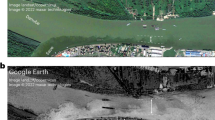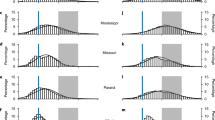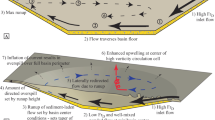Abstract
CHANNEL confluences have received considerable recent attention in the fields of geomorphology1–3, sedimentology4–9 and hydraulic engineering10–13. Where channels join, rapid changes in fluid velocity, turbulence intensity, channel hydraulic geometry and bed geometry may occur14–17. Previous models of junction dynamics have tended to assume that the confluent channels are of equal depth10,18, a condition that may be found only rarely in natural junctions; more often, the depths of confluent channels are different19. This discordance is commonly the result of the forma-tion, at the mouth of each confluent channel, of bars that possess steep avalanche faces which dip into a central junction scour1,2,5,20. Here we suggest that when channels of different depth join, the mixing layer that forms at their confluence is distorted by interacting with a separation zone which forms in the lee of the mouth of the shallower channel. This mixing-layer distortion imparts a complex three-dimensional flow to the junction, promoting vertical fluid upwelling and significantly enhancing rapid mixing within the flow of the shallow tributary, while retarding the rate of mixing across the flow of the deeper channel. Suspended sediments or contaminants within the deeper channel may be transferred rapidly across the flow of the shallower tributary, upwelling downstream of the junction.
This is a preview of subscription content, access via your institution
Access options
Subscribe to this journal
Receive 51 print issues and online access
$199.00 per year
only $3.90 per issue
Buy this article
- Purchase on Springer Link
- Instant access to full article PDF
Prices may be subject to local taxes which are calculated during checkout
Similar content being viewed by others
References
Mosley, M. P. J. Geol. 84, 535–562 (1976).
Ashmore, P. E. & Parker, G. Water Resour. Res. 19, 342–402 (1983).
Roy, A. G. & Bergeron, N. Geomorphology 3, 99–112 (1990).
Klassen, G. J. & Vermeer, K. Proc. Int. Conf. Fluvial Hydraul. Budapest, 1–14 (1988).
Best, J. L. Sedimentology 35, 481–498 (1988).
Mosley, M. P. & Schumm, S. A. Econ. Geol. 72, 691–694 (1977).
Reid, I., Best, J. L. & Frostick, L. E. in Floods: Hydrological, Sedimentological and Geomorphological Implications (eds Beven, K. & Carling, P.) 135–150 (Wiley, Chichester, 1989).
Bryant, I. D., Holyoak, D. T. & Mosely, K. A. Proc. Geol. Ass. 94(4), 321–343 (1983).
Best, J. L. & Brayshaw, A. C. J. geol. Soc. Lond. 142, 747–755 (1985).
Soong, H. K. thesis, Univ. Connecticut (1976).
Hager, W. H. J. hydraul. Engng 115, 243–259 (1989).
Sutherland, A. J. in Proc. 9th Aus. Fluid Mech. Conf. 259–263 (Univ. of Auckland, 1986).
Chu, V. H. & Babarutsi, S. J. hydraul. Engng 114, 1257–1274 (1988).
Richards, K. S. Water Resour. Res. 16, 241–244 (1980).
Best, J. L. & Reid, I. J. hydraul. Engng 110, 1588–1594 (1984).
Roy, A. G. & Woldenberg, M. J. J. Geol. 94, 401–411 (1986).
Roy, A. G. & Roy, R. Earth Surf. Proc. Landf. 13, 77–84 (1988).
Best, J. L., Soc. Econ. Palaeontalogists and Mineralogists spec. Publ. 39, 27–35 (1987).
Kennedy, B. A. Earth Surf. Proc. Landf. 9, 153–173 (1984).
Ashmore, P. E. Earth Surf. Proc. Landf. 7, 201–225 (1982).
Winant, C. D. & Browand, F. K. J. Fluid Mech. 63, 237–255 (1974).
Sternberg, H. O. The Amazon River of Brazil 74 (Steiner, Weisbader, 1975).
Roy, A. G. & De Serres, B. Bull. Soc. Géog. Liège 25, 113–127 (1989).
McGuirk, J. J. & Rodi, W. J. Fluid Mech. 86, 761–781 (1978).
Author information
Authors and Affiliations
Rights and permissions
About this article
Cite this article
Best, J., Roy, A. Mixing-layer distortion at the confluence of channels of different depth. Nature 350, 411–413 (1991). https://doi.org/10.1038/350411a0
Received:
Accepted:
Issue Date:
DOI: https://doi.org/10.1038/350411a0
This article is cited by
-
Scour pattern at zero-degree confluent channels
Acta Geophysica (2024)
-
How hydraulic jumps form downstream of a negative step with channel expansion: experimental and numerical investigations of the transitions between wave jumps and submerged jets
Environmental Fluid Mechanics (2024)
-
Mixing dynamics at river confluences governed by intermodal behaviour
Nature Geoscience (2023)
-
Indicators of Holocene high-stage flood events and tributary confluence migration in the lower Narmada Basin, western India
Journal of Earth System Science (2022)
-
The dynamics of river confluences and their effects on the ecology of aquatic environment: A review
Journal of Hydrodynamics (2022)
Comments
By submitting a comment you agree to abide by our Terms and Community Guidelines. If you find something abusive or that does not comply with our terms or guidelines please flag it as inappropriate.



